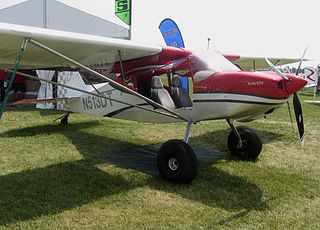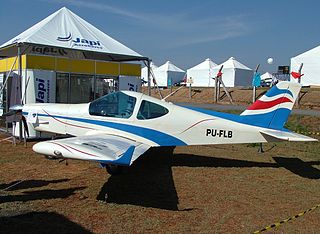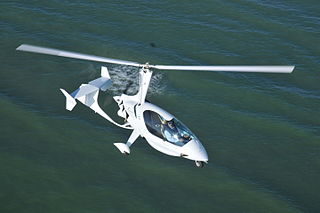Related Research Articles
The Eurofly FB5 Star Light is a single engine kit built Italian ultralight, seating two side by side. It first flew in the late 2000s.
The TeST TST-6 Duo is a Czech shoulder-wing, two-seats in side-by-side configuration motor glider that was designed and produced by TeST of Brno.

The Jora Jora is a high wing, T-tail, single-engine, two-seat ultralight designed in the Czech Republic in 1993. More than 160 had been sold by 2009.

The Groppo XL and Groppo Trail are very similar single engine, tandem seat, high wing ultralight aircraft designed and built in Italy. Both can be supplied complete or in kit form. The two models differ chiefly in undercarriage type.

The Microleve Corsario is a Brazilian amphibious ultralight flying boat that was designed and produced by Microleve of Rio de Janeiro. The aircraft was supplied as a kit for amateur construction.

The Etudes Andre Morin M85, or variously M 85 and M-85, is a French amateur-built aircraft that was designed by André Morin of Colombes. The aircraft is supplied in the form of plans for amateur construction.
The Butterfly Monarch is an American autogyro, designed and produced by The Butterfly LLC of Aurora, Texas. The aircraft is supplied as a kit for amateur construction.
The Apollo Monsoon is a Hungarian ultralight trike, designed and produced by Apollo Ultralight Aircraft of Eger. The aircraft is supplied as a kit for amateur construction or as a complete ready-to-fly-aircraft.
The ViS Sprint is a pusher configuration, pod-and-boom two-seat ultralight, designed and built in the Ukraine in the mid-2000s. It can serve as an agricultural spraying aircraft.
The Skyline SL-122 Bdzhilka is a twin engine agricultural spray aircraft designed and built in Ukraine and first flown in 2010.
The Las Brisas Mohawk is an American homebuilt aircraft that was designed and produced by Las Brisas Sales of Ozark, Missouri. When it was available the aircraft was supplied in the form of plans for amateur construction.

The Rans S-20 Raven is an American homebuilt aircraft that was designed by Randy Schlitter and is produced by Rans Designs of Hays, Kansas, introduced at AirVenture in August 2013. The aircraft is supplied as a kit for amateur construction and it is anticipated that it will later be offered as a complete ready-to-fly-aircraft in the light-sport aircraft category.

The Storm RG Fury is an Italian microlight aircraft, designed and produced by Storm Aircraft of Sabaudia. Storm Aircraft was originally called SG Aviation srl. The aircraft is supplied complete and ready-to-fly.
The Air Command Commander Sport is an American autogyro that was designed and produced by Air Command International of Wylie, Texas. Now out of production, when it was available the aircraft was supplied as a kit for amateur construction.
The Rotorwing-Aero 3D-RV is an American autogyro that was designed by Monte Hoskins and produced by Rotorwing-Aero of Salt Lake City, Utah, introduced in 1989. Now out of production, when it was available the aircraft was supplied in the form of plans for amateur construction.

The ELA Aviation ELA 10 Eclipse is a Spanish, two place, enclosed autogyro, designed and built by ELA Aviación of Córdoba, Andalusia, introduced at the AERO Friedrichshafen airshow in 2014. The aircraft is supplied complete and ready-to-fly.
The Rokospol Via is a Czech ultralight and light-sport aircraft (LSA), designed and produced by Rokospol Aviation of Prague, introduced at the Prague airshow in 2008. The aircraft is supplied complete and ready-to-fly.
The Aviomania G2SA Genesis Duo is a Cypriot autogyro designed in 2007 by Nicolas Karaolides and produced by Aviomania of Larnaca. The aircraft is supplied as a complete ready-to-fly-aircraft or as a kit for amateur construction.
The SkyCruiser Autogyro SkyCruiser is a series of Hungarian autogyros designed and produced by SkyCruiser Autogyro KFT of Inárcs. It was publicly introduced at the AERO Friedrichshafen airshow in 2014. The aircraft is supplied complete and ready-to-fly.
The NAU Black-headed Gull is a Chinese two seat, high wing ultralight first flown in 2011.
References
- 1 2 3 4 5 6 7 8 9 Gunston, Bill (2016). Jane's All the World's Aircraft : development & production : 2016-17. IHS Global. ISBN 978-0-7106-3177-0.
- 1 2 3 4 5 "Il biposta di Indiana Jones" (PDF). Volare Sprt: 74. June 2013.
- 1 2 3 Tacke, Willi; Marino Boric; et al: World Directory of Light Aviation 2015-16, page 68. Flying Pages Europe SARL, 2015. ISSN 1368-485X